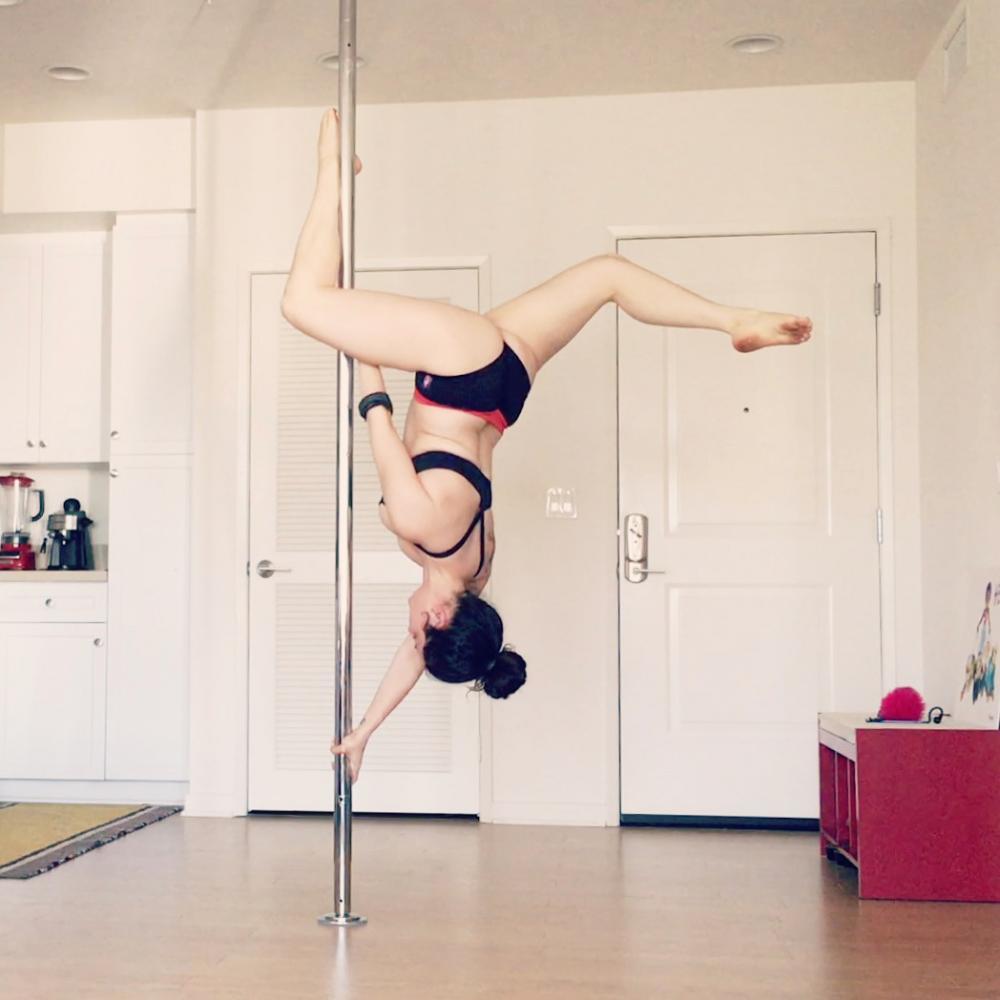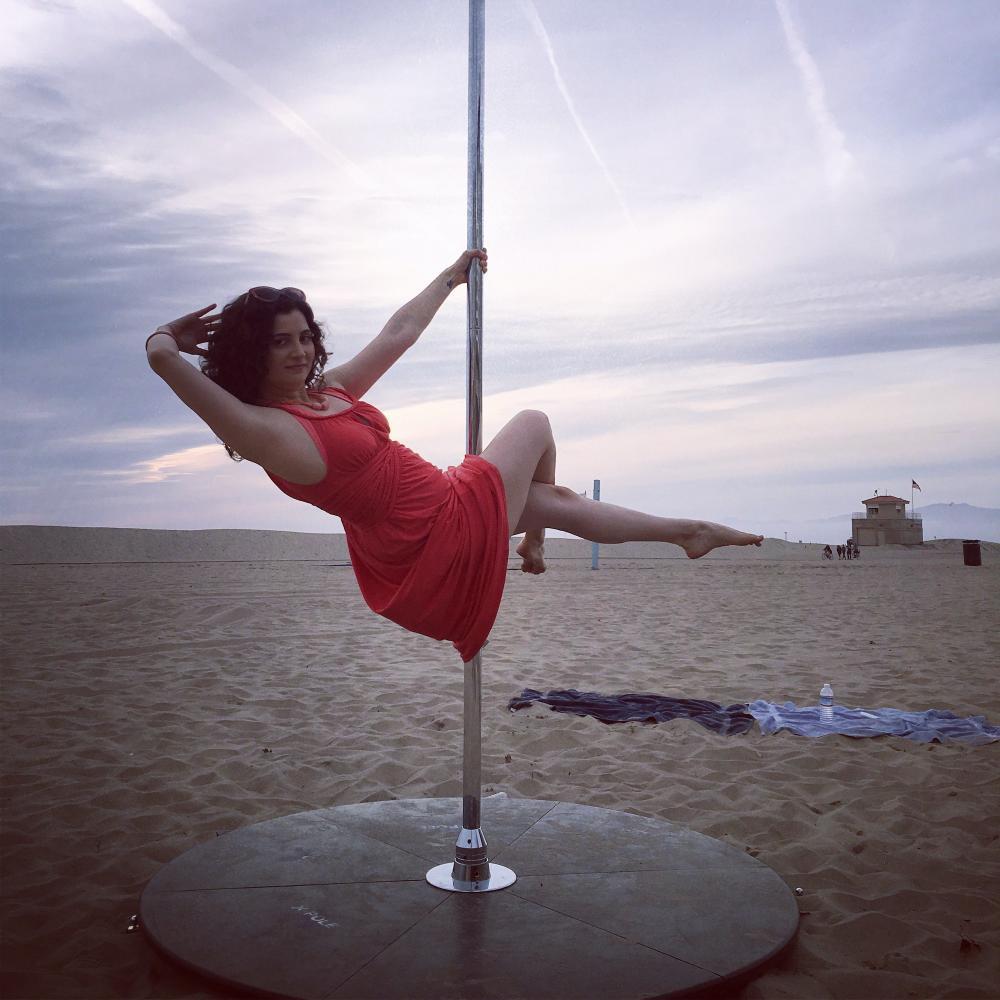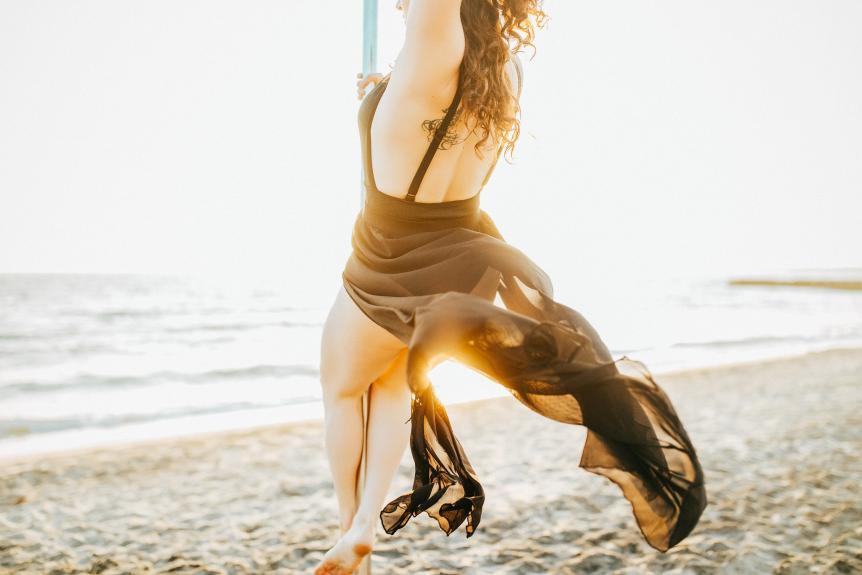So you’re ready to commit to your pole dancing practice by installing your own pole at home. Awesome! It’s an exciting step to take and makes even more sense now with social distancing policies temporarily closing down pole dancing studios across the world. Many teachers are making online pole classes available, which means you can continue pole dancing and working out on your home pole through the pandemic. You can even take classes with out-of-town instructors whose classes weren’t available to you before.
You can get a solid home pole for anywhere between $200-$400. The most important thing to consider when buying a home pole dancing kit is safety. Our bodies put an incredible amount of physical force on the pole whenever we fly. It’s very scary when poles fall down as they’re being used. You could get severely injured, along with any other people or pets in the room.
I’ve seen home poles fall twice. The first happened a couple of weeks before I moved out of my apartment at the time. I’d had my pole up for over a year and a large guy decided to take it for a spin at my moving-out party. The second was a temporary setup for one night at a party where the ceiling was too high for the pole to be secure. Fortunately, no one got hurt and no property was damaged in either incident. But it’s something I don’t ever want to happen again under my watch.
Don’t just take my word for it. You can find plenty of examples of home poles gone wrong on the @polelols account – and they only post submissions that are confirmed injury-free. The running joke is that most of the poles that fail are discount brands from Amazon or Wish.
For safe pole fitness at home, always make sure to:
- Buy a reputable brand of pole – do not trust your safety to the bargain bin!
- Follow the instructions carefully when installing your pole at home
- Measure and order the proper extensions for your ceiling height
- Position your pole under a stud in your ceiling
- Check that your pole is level on a regular basis
- Clear out plenty of space around your pole for dancing
In this blog post, I’ll review the two most reputable pole brands and the only home poles I personally recommend: X-Pole and Lupit Pole. I advise buying directly from the manufacturer but sometimes you can get lucky and find a gently used version for sale on Craigslist for cheaper. Just make sure the pole comes in its original packaging so that you know it’s legit.
As a disclaimer, this post has affiliate links. That means I could get a small commission for products that you purchase through my site. This does not affect the price you pay or the way I write about the products. I only recommend items that I would personally buy and use.
While you’re here, you can check out my pole playlists with over 400 songs and the many beautiful pole shoes I’m currently lusting over. I recommend these pole dancing accessories to take your practice to the next level. Remember that as pole dancing hobbyists, it’s important for us to be allies to sex workers. You can read more about my personal pole dancing journey here.
Home Pole Types: Bolted or Pressure-Mounted
If you rent an apartment or you don’t have the option of making permanent changes to your home, no worries! The most popular home pole models are pressure-mounted, which makes them portable, removable, and damage-free, even for popcorn ceilings.

Most pressure-mounted poles are super easy to install at home, although you will want a buddy to help you. The installation kit comes with everything you need to set up your pole – no drills necessary – and the manufacturers have instructional videos online. Pressure-mounted poles need a flat, level ceiling to brace against. You can also increase the stability of pressure-mounted poles by positioning a square piece of plywood between the top disk and the ceiling.
If you own your home and you have the space to permanently dedicate to your pole, you can bolt your pole directly to the ceiling. I can’t wait until I have a place where I can do this. Pressure-mounted poles are safe when installed properly but nothing is as safe as bolting your pole into place if possible.
Bolting might be necessary if your ceilings are slanted or very high. If you have nowhere on your ceiling to properly install your pole, you can always go for a freestanding stage pole, too.
Buying the Best Home Pole for You: Sizing and Finish
If you pole dance in the United States, chances are your pole studio has 45mm diameter poles. 45mm is actually considered the competition standard for poles in the U.S. Unless you have a special need for a thinner or thicker pole, it’s best to get the 45mm size.
50mm poles are most often found in clubs. If you’ve worked as a dancer you may have used these thicker poles. Meanwhile, thinner 40mm poles are more commonly used in Australia.
The most common materials for pole finish are chrome, stainless steel, brass, titanium gold, silicon, and powdered coating. If you have hands that tend to be slippery and slick, you could opt for a more sticky material to help with your grip at home.
- Chrome poles are the most popular and widely available, but they can cause problems for people who have nickel allergies or sensitive skin.
- Stainless steel poles are great for dancers with allergies and sensitive skin but may be difficult to grip if you have naturally dry skin or live in a dry climate.
- Brass is another hypo-allergenic alternative. Many pole dancers love brass for grip in sweaty palms and humid climates. However, if you tend to be sticky to the pole, brass may be too sticky for you.
- Titanium gold is more expensive but touted for its superior stickiness and grip because of its ability to conduct and maintain heat from your touch.
- Powder coating comes in different colors and can provide a better grip if that’s something you need.
- Silicon poles weigh and cost less than metal but you don’t see them out in the wild a lot. They’re soft but very grippy, so much so that you can actually wear long sleeves and pants and still climb. Silicon poles are great for dancers who want to stay covered while they dance!
Your ideal home pole depends on your personal preferences, skin type, and grip. If you don’t have any allergies or preferences, chrome is the best place to start.
Make sure to measure your ceiling height before ordering your pole. This is a step you absolutely should not skip! Don’t hesitate to order extensions when you need them. Your pole should be as close to a fit for your ceiling height as possible, otherwise you risk stretching it too thin.
Static, Spin, and Freestanding Stage Poles
Most home poles have two settings: static and spin. You get both modes in the same pole.
Older poles use a hex key to loosen two screws at the bottom of the pole to switch between static and spin. Newer pole models feature an easy latch to switch between the two modes – with no hex keys or screws.
X-Pole offers a static-only (no-spin) pole option called the X-Pole Sport, which is cheaper and advertised as a “starter pole.” This was the first pole that I got – and I regretted it. I didn’t think I would use spin pole very much, but I ended up missing that feature later on. I upgraded to the static-spin combined X-Pole X-Pert shortly after. I highly recommend getting a pole with both static and spin. It’s always nice to have the option to do either.
Stage poles are freestanding dance poles grounded by a circular metal base. These are great if you have really high or slanted ceilings, or if you want to pole outside! Because they come with their own stage to create stability for the pole, these are very heavy and a little pricier.

Where Should I Set up My Home Pole?
When setting up your pole at home, pick a place:
- With a smooth, flat floor surface and a flat ceiling with a stud,
- Where you have as much room as possible around the pole, preferably enough to spread both arms out, or about 6 feet in all directions, and
- Without obstacles near the ceiling.
A dedicated room would be ideal, somewhere you can spread out and focus on your pole practice. But many people don’t have a lot of extra space. Your pole could end up in the middle of your living space, wherever you happen to have an open area to spare. Fortunately, portable home poles are removable. Their engineering is impressively simple so you can put them up and take them down easily.
Currently, my home pole stays up in the area between my kitchen and living room in my apartment. You’d be surprised how easily you get used to it being there. Comically, some friends who enter my home for the first time don’t notice the pole right away, even though it’s literally standing right in front of them. Their brain catalogs it as a part of the apartment, like a support pillar. Then, 30 minutes later, they’ll blink at the pole and say, “Wait. Is that… a pole dancing pole?” Yep!
Even if you’re working with a small space, a few personal touches can help make it somewhere to clear your mind, focus on your movement, and get in touch with your sensual side.
- Make sure to have a mirror. Seeing yourself dance helps refine your movement. Big mirrors can be expensive and heavy. There are smaller, more affordable options online that will work.
- Consider string lights for a soft glow or a colored lightbulb for a shift in vibe.
- Keep your pole gear (grip, kneepads, socks, etc.) nearby for easy access.

Can I Set up My Home Pole on the Carpet?
Yes! You can absolutely set up your home pole on the carpet. Hardwood or smooth floors are preferable, but carpeted floors are totally doable. They may even be preferable if you live in an upper-floor apartment and you want to avoid disturbing your neighbors downstairs.
Your experience will no doubt be a little different on carpet compared to hardwood or smooth floors. You may have to relearn how to balance on heels in your carpeted bedroom. And you may get some carpet burn, but pole dancers are no strangers to red skin. Consider it another type of pole kiss. Or invest in leg warmers and stick to boots for extra ankle stability and toe protection.
Now that you know what to look for, let’s take a look at your home pole options!
The Best Dance Poles for Home Use: X-Pole Review
X-Pole is a staple in the pole world. Their poles are used in pole dancing studios, competitions, and performances around the globe. X-Pole products are engineered with high standards of quality and safety and backed up with excellent customer service.
The X-Pole XPERT Pro is the best at-home option for pole dancers of all levels. I have had my XPERT for almost 4 years. The XPERT’s new design incorporates the convenient X-LOCK mechanism, which makes it super easy to switch between static and spin modes with just a twist!
If you have an older X-Pole XPERT, you can upgrade by buying just the X-LOCK mechanism.
X-Pole comes in diameter sizes 40mm and 45mm, with finishes in chrome, stainless steel, brass, titanium gold, powder coating (black, pink, white), and silicon (black, pink). The basic kit fits ceiling heights between 7’6” and 9’1”, plus extensions go up to 11’1”. On the website, you can input your ceiling height and figure out what extensions you need. The disks at the top and bottom of the pole include rubber protection to keep your floor and ceiling damage-free.
If your ceiling is shorter than 7’6”, you can simply get the 750mm extension and replace the top piece in the standard kit with the shorter extension. Ceiling mounts are recommended for poles over 11 feet high. Any pole over 14 feet high gets very flexible, bendy, and wobbly, and you might be better off with a freestanding stage pole instead. Contact X-Pole customer support if you have questions.
For freestanding stage poles with platforms, check out X-Pole’s 10-foot X-Stage and X-Stage Lite. X-Pole’s stage poles have both static and spinning modes.
X-Pole is very popular so some of their models may not always be available. You can keep in touch with the brand @xpoleus or contact their customer support for stock updates.
The Best Dance Poles for Home Use: Lupit Pole Review
Lupit Pole burst onto the pole world in 2018. They’ve established a name for themselves with quality poles that rival the safety and standards of X-Pole.
The Lupit Classic G2 is a highly-rated static and spin option for home poles. It comes in chrome, stainless steel, and black powder-coated. Diameter options are 42mm and 45mm. Lupit boasts that their chrome finish is nickel-free and extra “grippy” for slippery hands. The base pole model goes up to 9’2” with extensions up to 11 feet. Lupit’s static-spin mechanism is similar to the X-LOCK, with easy switching between modes.
Lupit pressure-mounted poles are simple to install, with no drilling necessary. They are fully removable, portable, and designed to be damage-free. Follow them @lupitpole.
Lupit Pole also has stage poles, including a version with long base legs for added stability.
Remember: never trade your safety for price! Lower-quality poles can have cheap metal and plastic parts that fail easily. You want industrial-grade metal, strong bearings, and a solid finish. It’s more expensive, but you stand to lose a lot more if you hurt yourself on a cheap pole.
As long as you stick to trusted brands like X-Pole and Lupit Pole, you can’t go wrong.
Lupit Pole Dancing Crash Mats
You definitely don’t need crash mats to start poling at home. But if you want a set, Lupit pole has crash mats in different colors. I have a pair but I personally don’t use them that often.
Always be careful when you’re pole dancing at home. A crash mat is not a replacement for an experienced spotter. But the extra cushion can help you feel more secure in tricks where you just need a little bit of confidence to solidify the move.
Happy poling at home! Comment below if you have any questions or thoughts. I’d love to hear about your experience with different types of home poles.

Comments
Thank you so much! This was super helpful!
Glad to hear it! ❤️
Hi, thanks a lot for your article! One question: do you know if one of the pole you advise can be bolted? Otherwise, do you know a good bolted model ?
Hi Stephanie! Both X-pole and Lupit Pole have permanent ceiling mounting and bolting options! You can find them here for X-Pole and here for Lupit. Good luck!
Is there a weight limit? How do these not fall if a larger person is using it for workouts?
Hi Lindsey! Here is an explanation about pole weight limits from the Lupit Pole FAQ page – “The maximum weight of the dancer performing on the pole cannot be calculated or advised. It is important to understand that the real limitation is the lateral force which is produced by the performer. For example, a very thin and light dancer can spin very fast and produce a quite large centrifugal force that can be equal or larger than a force produced by a heavy performer doing slow and gentle moves. Generated lateral force can also be applied to the different height of the pole which is of a different height mounted between different flooring and different ceilings. There are too many variables to be taken into consideration to calculate the correct braking force.”
If you have concerns about reaching your pole’s weight limit, the safest option would be to install and bolt the pole directly to the floor and/or ceiling with hardware. I hope this helps!